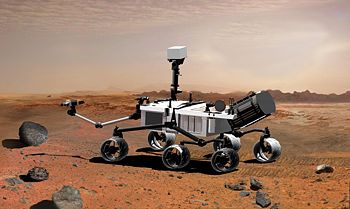NASA announces that it is postponing the next mission to Mars to the fall of 2011, as part of the mission a next-generation rover and an unprecedented amount of scientific instruments will be launched to investigate the early environmental history of our red neighbor

The original launch date was set for October 2009, but tests showed that there are technical problems that endanger the success of the mission. The time window for the launch during the year 2009 ends towards the end of October and this is because the relative position between the Earth and Mars is in the optimal range only once every two years for a short period of several weeks. The next window of opportunity will only be in 2011.
The managers of the program at NASA state that they do not intend to lower the standards of the preliminary tests, therefore the responsible decision for them would be to postpone the launch date. According to those sources, up to this point all the efforts invested in the program were based on the assumption that the launch will be carried out next year both from the scientific side and from the economic side, now the teams will only have more time to prepare for the mission and carry out comprehensive tests of the equipment.
On the left Spirit and Opportunity [2004] on the right Mars Science Labratory [2011]. (Source: NASA)”]![Three generations of rovers: in the middle Petfinder [1997] on the left Spirit and Opportunity [2004] on the right Mars Science and Bratory [2011]. (Source: NASA) Three generations of rovers: in the middle Petfinder [1997] on the left Spirit and Opportunity [2004] on the right Mars Science and Bratory [2011]. (Source: NASA)](https://www.hayadan.org.il/images/content2/space/mars_science_laboratory2.jpg)
Recently, the team of the Mars Science Laboratory mission completed an assessment of the work carried out in recent months and came to the conclusion that there is no escape from delaying the launch. "Despite the comprehensive work by the dedicated teams, the progress in recent weeks has not progressed at a sufficient pace to overcome the engineering challenges", said Charles Elhi, "the right and smart decision for a successful mission is to postpone the launch to 2011". NASA states that the cost considerations of each mission are carefully considered, but the determining factor is the chance of the mission's success.
The advanced rover to be launched is one of the most complicated interstellar missions built so far, it will use new techniques to correct its trajectory while landing in the Martian atmosphere. The advanced research equipment will weigh 10 times the equipment that was on the Spirit and Opportunity missions. The equipment will include equipment for analyzing soil samples, from drilling powder from rocks. The mission was designed to travel greater distances over more rugged terrain than any previous rover mission. And the new rover will use a completely new ground propulsion system.
There are currently four optimal landing targets photographed by NASA compasses. When the route is selected and the rover lands, its purpose will be to explore the landing area and its surroundings, and find evidence that teaches about the environmental history of Mars. The stated goal is to check whether there were conditions on Mars that supported microbial life and whether there is evidence that these conditions have been maintained to this day.
A flagship project
At the press conference convened on Thursday for the announcement, NASA Administrator Michael Griffin explained that, "attempting to prepare the spacecraft for launch in 2009 will increase the risks, which is not suitable for a flagship project."
This is the second time in two years that NASA has had to postpone a mission to Mars. Last year, the agency postponed the planned 2011 launch of the Mars atmospheric probe due to a conflict of interest in the project selection process.
As Earth and Mars move closer to launch distance, once every 26 months, NASA will launch the mobile science laboratory in 2011 instead of the postponed orbiter. In any case, the project itself is several months behind the planned schedule.
Following the last two incidents, NASA decided to contact the European Space Agency ESA. The two agencies agreed that from now on, all missions to Mars will be joint, including a spacecraft that will dig and return samples to Earth. The negotiations between the two agencies on the subject began in July of this year and it was revealed by NASA's deputy director responsible for space sciences, Ed Weiler at the same press conference in which NASA announced the postponement of the launch of the science laboratory.
And in the meantime it was announced that China will join a Russian satellite launch to Mars and launch its first satellite to the red planet. "Ying-ho 1" (the meaning of the name Ying-ho is Mars). The Chinese intend to land a probe on the moon in 2012, and send humans there in 2020.

3 תגובות
It is a shame that it is being rejected because the topic is very important and interesting
It's a shame that the expectation is postponed in two years. The soul is very thirsty for information from Mars. But it may be the right thing to do. What is certain is that it would be good if more and more money was invested in Mars exploration and less money in wars.
Soil samples from Mars are a real wet dream. A first Chinese delegation in 2020 also sounds promising and closer than ever.
Greetings friends,
Ami Bachar
Can you give me some details about it? What system is it about? What is unique about it?
Thanks.